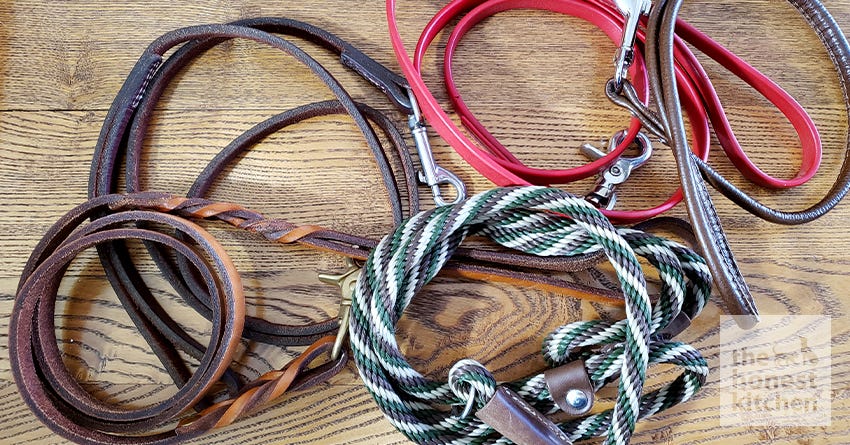The purpose of a leash is to connect you to your dog.
By doing so you can keep him safe, prevent unwanted behaviors, and ideally, communicate with him. There are so many different types of leashes, though, that choosing one can be incredibly confusing. So let's talk about leashes.

New leather leashes may be stiff, but well-worn ones are soft and comfortable.
What materials are leashes made out of?
Leashes can be found in a variety of materials, from leather to chain to biothane. Each has their fans and their pros/cons. Leather leashes have been the standard for dog trainers for generations. Although a new leather leash needs some seasoning to lose its stiffness, there is nothing like a well-used leather leash softened by use and hand oils. Leather is sturdy and a softened one is easy on the hands. The downside to them is an untrained dog may want to chew on the leather and if a leather leash gets too wet, it will need some care. A good quality leather leash is not inexpensive but with care will last for several generations of dogs. Nylon, cotton, and other web leashes are popular, too—and commonly sold in a variety of lengths, from 4 foot to 6 or 8 feet long. Long lines (see below) are often made from cotton web. These leashes are easy to clean and inexpensive. The downside is these leashes may burn your hands if a dog pulls hard. Chain leashes are generally chosen by the owners of dogs who chew their leashes as the chain is virtually un-chewable. Unfortunately, chain leashes are hard on your hands and weigh heavily on your dog's neck. Plus, if your dog chews on the chain he can break a tooth. Be cautious with these leashes. The past decade has seen the introduction of biothane leashes (as well as collars and other dog and horse equipment). Biothane is the brand name of a coated webbing made by the Biothane Coated Webbing Corporation. A webbing material is coated, making it softer on the hands (and animal) while remaining strong and more weather resistant. The leashes are colorful and long-lasting. Round poly type ropes much like climbing ropes have become popular for leashes. Used as clip leashes or slip leashes (a combination slip collar and leash) these leashes are sturdy yet soft on the hands.

Traffic leads are designed to stretch between your dog's collar and your hand while your dog is walking in the heel position. The left one has a scissor clip and the right one a bolt snap.
Leash Clips Vary, Too
Just as leash materials vary, so do clips. The most common leash clip is a bolt snap. This is inexpensive and is available in a wide variety of sizes. Choose a leash with a bolt snap larger and heavier than you might think your dog needs, as the smaller sizes can break if used on a strong or heavy dog. The scissors clip is a strong clip that is less likely to break than bolt snap. Because of this, you'll be seeing them on more and more leashes.

Slip leashes are usually made from climbing rope type material.
How long should a leash be?
Dog trainers generally prefer leashes that are four to six feet in length. Shorter than four feet inhibits the training of some obedience exercises and longer than six makes leash handling clumsy as there is too much leash. Most dog training classes then recommend leashes of these lengths. Plus walking your dog on these leash lengths is comfortable. Traffic leashes are leashes just long enough to reach from your dog's collar to your hand. These are usually six to twelve inches long, again, depending on the dog's height as well as the owner's. These leashes are excellent for walking in situations where the dog must (or should) remain in a heel position; such as in a crowd. Longer leashes, often called long lines, may be 15 to 20 feet in length and sometimes even longer. These are useful when training distance exercises such as the down, stay, or come but are too long to be used for comfortable walking. Some dog sports, such as tracking, use long leashes. Retractable leashes are generally longer than standard leashes, often from 10 to 20 feet. These leashes are sometimes used in place of long lines when training distance work but are more often used by pet owners who wish to give their dog more distance during a walk. As such, they can be dangerous as this distance can allow the dog to go into the street or interfere with other dogs and people. Specialized leashes are available, too, including leashes that attach to a bicycle so your dog can run alongside. Leashes that attach to your body so you can free up your hands are popular with runners. If you walk more than one dog, there are leashes that have two or three individual leashes attached to one handle. If dog owners have wished for a certain kind of leash, someone has probably made one!

There are so many leashes. Which is right for you and your dog?
Choosing a Leash
All leashes have pros and cons, so when choosing a leash, think about what you want from it. Is it for walking, training, or sport? Therapy dogs, for example, when working must be on a four-foot or shorter leash. Tracking leashes, on the other hand, are usually 15 to 20 feet long. The leash must be strong enough for your dog—especially if you have a young, rowdy, untrained dog who may pull on the leash. The type of leash, leash material, and clip need to be strong enough not to break. On the other hand, if you have a small dog, don't put a heavyweight leash and big clip on him. It will be too heavy on his neck and body. Last but certainly not least, the leash should be comfortable in your hands. Rope or web burns are not fun.

